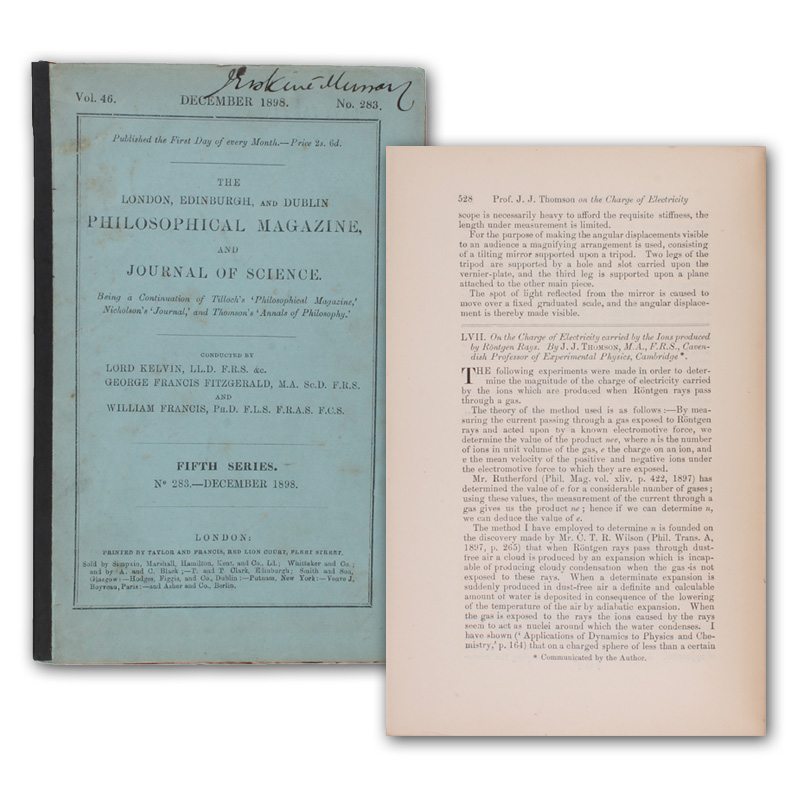114719-01
On the charge of electricity carried by ions produced by Röntgen rays. SS. 528-545. Mit 1 Abbildung. In: The London, Edinburgh, and Dublin Philosophical Magazine and Journal of Science. 5th series. Vol. 46, No. 283.
London, Taylor & Francis, 1898. - (22,5 x 14,5 cm). SS. 509-576, VII S. Mit Abbildungen. Original-Broschur, unbeschnitten.
Erste Ausgabe. - "It was reserved for J. J. Thomson to discover the true nature of the cathode rays. In April 1897 he gave a public demonstration... in which he declared that cathode rays are composed of particles of sub-atomic proportions. At this stage, he had been unable to calculate the weight of the particles, but he had measured their rate of charge to mass. The ratio was large, so they must either have a big charge or a small mass... If the charge could be calculated, then the mass could be found, since the ratio between the two was known.Thomson eventually succeeded in calculating the charge, by an ingenious adaptation of the 'dust counter' devised by C. T. R. Wilson... By observing variations in their fall in various electric fields he was able to calculate the electric charge on the particles. These experiments... led to the calculation of the mass of the electron as one eighteen-hundredth of a hydrogen atom, hitherto the lightest known object. Moreover the mass of these 'corpuscles', as Thomson called them, was constant, whatever their origin. That is to say that all forms of matter, no matter how varied their chemical composition, produced cathode rays of uniform make-up. The reference to 'Röntgen rays' in (the above article) indicates their identity with cathode rays" (PMM). - Umschlag leicht fleckig und mit handschriftlichem Namenszug. Rücken sauber überklebt, sonst gut erhalten. - DSB 13, 371, 27; PMM 386 (c)
On the charge of electricity carried by ions produced by Röntgen rays. SS. 528-545. Mit 1 Abbildung. In: The London, Edinburgh, and Dublin Philosophical Magazine and Journal of Science. 5th series. Vol. 46, No. 283.
London, Taylor & Francis, 1898. - (22,5 x 14,5 cm). SS. 509-576, VII S. Mit Abbildungen. Original-Broschur, unbeschnitten.
Erste Ausgabe. - "It was reserved for J. J. Thomson to discover the true nature of the cathode rays. In April 1897 he gave a public demonstration... in which he declared that cathode rays are composed of particles of sub-atomic proportions. At this stage, he had been unable to calculate the weight of the particles, but he had measured their rate of charge to mass. The ratio was large, so they must either have a big charge or a small mass... If the charge could be calculated, then the mass could be found, since the ratio between the two was known.Thomson eventually succeeded in calculating the charge, by an ingenious adaptation of the 'dust counter' devised by C. T. R. Wilson... By observing variations in their fall in various electric fields he was able to calculate the electric charge on the particles. These experiments... led to the calculation of the mass of the electron as one eighteen-hundredth of a hydrogen atom, hitherto the lightest known object. Moreover the mass of these 'corpuscles', as Thomson called them, was constant, whatever their origin. That is to say that all forms of matter, no matter how varied their chemical composition, produced cathode rays of uniform make-up. The reference to 'Röntgen rays' in (the above article) indicates their identity with cathode rays" (PMM). - Umschlag leicht fleckig und mit handschriftlichem Namenszug. Rücken sauber überklebt, sonst gut erhalten. - DSB 13, 371, 27; PMM 386 (c)
450 €

